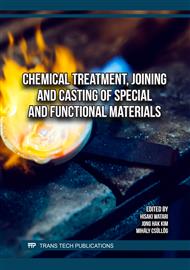[1]
F. Cheng, Y. Hu, X. Zhang, X. Hu, and Z. Huang, "Adhesive bond strength enhancing between carbon fiber reinforced polymer and aluminum substrates with different surface morphologies created by three sulfuric acid solutions," Compos. Part A Appl. Sci. Manuf., vol. 146, p.106427, 2021.
DOI: 10.1016/j.compositesa.2021.106427
Google Scholar
[2]
F. C. Sousa et al., "Investigation of geometric and material effects on the fatigue performance of composite and steel adhesive joints," Compos. Struct., vol. 344, no. June, p.118313, 2024.
DOI: 10.1016/j.compstruct.2024.118313
Google Scholar
[3]
C. Bagni, A. Halfpenny, M. Hill, and A. Tarasek, "A practical methodology for the fatigue life estimation of adhesive joints," Procedia Struct. Integr., vol. 57, no. 2022, p.598–610, 2023.
DOI: 10.1016/j.prostr.2024.03.066
Google Scholar
[4]
F. Mannino, D. V. Srinivasan, D. Fanteria, and A. P. Vassilopoulos, "Standard specimen geometries do not always lead to consistent fatigue results for epoxy adhesives," Int. J. Fatigue, vol. 190, no. June 2024, p.108600, 2025.
DOI: 10.1016/j.ijfatigue.2024.108600
Google Scholar
[5]
P. Vigón, A. Argüelles, M. Lozano, and J. Viña, "Fatigue behavior of adhesive joints under modes I and II fracture in carbon-epoxy composites, influence of exposure time in a saline environment," J. Adv. Join. Process., vol. 9, no. April, 2024.
DOI: 10.1016/j.jajp.2024.100225
Google Scholar
[6]
L. Duan et al., "Investigation on shear and fatigue performance of CFRP/aluminum alloy single-lap adhesive joint," Thin-Walled Struct., vol. 196, no. April 2023, p.111421, 2024.
DOI: 10.1016/j.tws.2023.111421
Google Scholar
[7]
C. W. Chu, C. H. Cheng, K. Obayashi, R. A. H. Bayomi, A. Takahara, and K. Kojio, "Effects of curing conditions on adhesive and fatigue properties of hydrogenated epoxy resins in bulk state and single-lap-joint configuration," Int. J. Adhes. Adhes., vol. 132, no. March 2023, p.103690, 2024.
DOI: 10.1016/j.ijadhadh.2024.103690
Google Scholar
[8]
F. C. Sousa, P. Zamani, A. Akhavan-Safar, and L. F. M. da Silva, "A comprehensive review of the S-N fatigue behaviour of adhesive joints," J. Adv. Join. Process., vol. 9, no. December 2023, p.100178, 2024.
DOI: 10.1016/j.jajp.2023.100178
Google Scholar
[9]
X. Zhang, Y. Ju, A. Zhu, and T. Zou, "Fatigue behavior of single-lap adhesive joints with similar and dissimilar adherends under cyclic loading: A combined experimental and simulation study," Mater. Today Commun., vol. 37, no. 2898, p.107215, 2023.
DOI: 10.1016/j.mtcomm.2023.107215
Google Scholar
[10]
V. Kumar, S. Sharma, and A. Singh, "Impact of joint variables on shear and fatigue behavior of composite-metal single-lap adhesive joint," Eng. Fail. Anal., vol. 168, no. November 2024, 2025.
DOI: 10.1016/j.engfailanal.2024.109079
Google Scholar
[11]
F. Castro Sousa, A. Akhavan-Safar, R. J. C. Carbas, E. A. S. Marques, A. Q. Barbosa, and L. F. M. da Silva, "Experimental study on the influence of environmental conditions on the fatigue behaviour of adhesive joints," Int. J. Fatigue, vol. 175, no. February, p.107752, 2023.
DOI: 10.1016/j.ijfatigue.2023.107752
Google Scholar
[12]
J. Zhang, H. Y. Li, H. Jia, and H. Li, "Experimental investigation on multiaxial ratchetting behaviour and fatigue life of silicone seal adhesive bonding butt-joints," Int. J. Adhes. Adhes., vol. 103, no. August, p.102700, 2020.
DOI: 10.1016/j.ijadhadh.2020.102700
Google Scholar
[13]
S. Safaei, L. M. Martulli, A. Bernasconi, and M. Carboni, "Modelling the static and fatigue behavior of hybrid spot welded-adhesively bonded single lap joints," Int. J. Adhes. Adhes., vol. 130, no. September 2023, p.103619, 2024.
DOI: 10.1016/j.ijadhadh.2024.103619
Google Scholar
[14]
A. I. M. Foletti, J. Sena Cruz, and A. P. Vassilopoulos, "Fabrication and curing conditions effects on the fatigue behavior of a structural adhesive," Int. J. Fatigue, vol. 139, no. March, p.105743, 2020.
DOI: 10.1016/j.ijfatigue.2020.105743
Google Scholar
[15]
H. J. Gudladt and S. Frömmel, "Fatigue and fracture behavior of adhesive-bonded structures in the light of the surface morphology," Int. J. Adhes. Adhes., vol. 88, no. October 2018, p.74–80, 2019.
DOI: 10.1016/j.ijadhadh.2018.10.016
Google Scholar
[16]
V. C. Beber and M. Brede, "Multiaxial static and fatigue behaviour of elastic and structural adhesives for railway applications," Procedia Struct. Integr., vol. 28, p.1950–1962, 2020.
DOI: 10.1016/j.prostr.2020.11.018
Google Scholar
[17]
G. Riedl, F. Baldi, and G. M. Wallner, "A slope-based J-integral approach and advanced image processing for assessment of the cyclic fatigue delamination behavior of adhesive joints," Int. J. Fatigue, vol. 192, no. November 2024, p.108730, 2025.
DOI: 10.1016/j.ijfatigue.2024.108730
Google Scholar
[18]
B. Schneider, V. C. Beber, J. Schweer, M. Brede, and B. Mayer, "An experimental investigation of the fatigue damage behaviour of adhesively bonded joints under the combined effect of variable amplitude stress and temperature variation," Int. J. Adhes. Adhes., vol. 83, p.41–49, 2018.
DOI: 10.1016/j.ijadhadh.2018.02.011
Google Scholar
[19]
Y. Doroudi, D. Fernando, A. Hosseini, and E. Ghafoori, "Behavior of cracked steel plates strengthened with adhesively bonded CFRP laminates under fatigue Loading: Experimental and analytical study," Compos. Struct., vol. 266, no. September 2020, p.113816, 2021.
DOI: 10.1016/j.compstruct.2021.113816
Google Scholar
[20]
Z. Jiang, S. Wan, Z. Fang, and A. Song, "Experimental investigation of fatigue behavior for adhesively-bonded GFRP/steel joints," Eng. Struct., vol. 213, no. March, p.110580, 2020.
DOI: 10.1016/j.engstruct.2020.110580
Google Scholar



